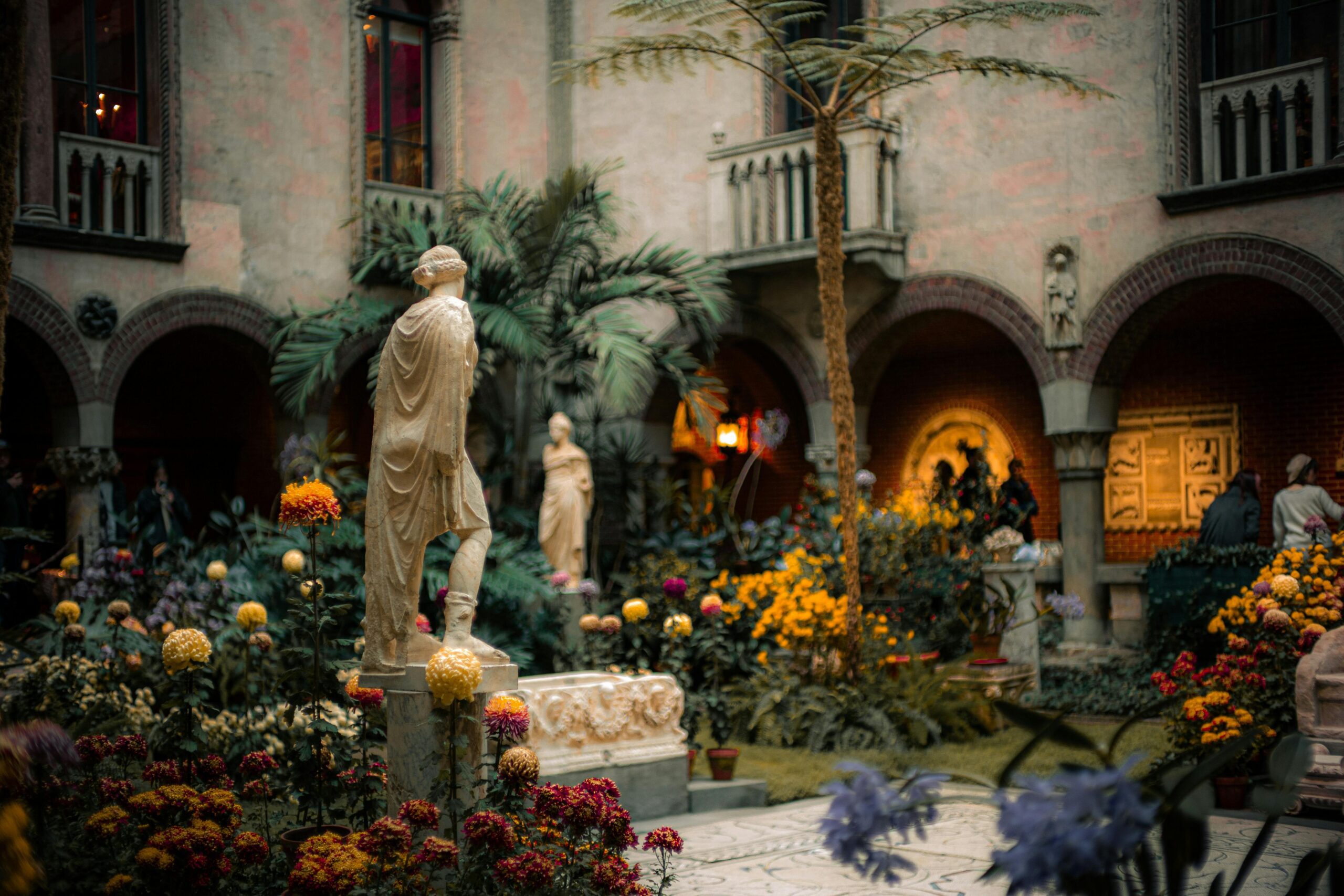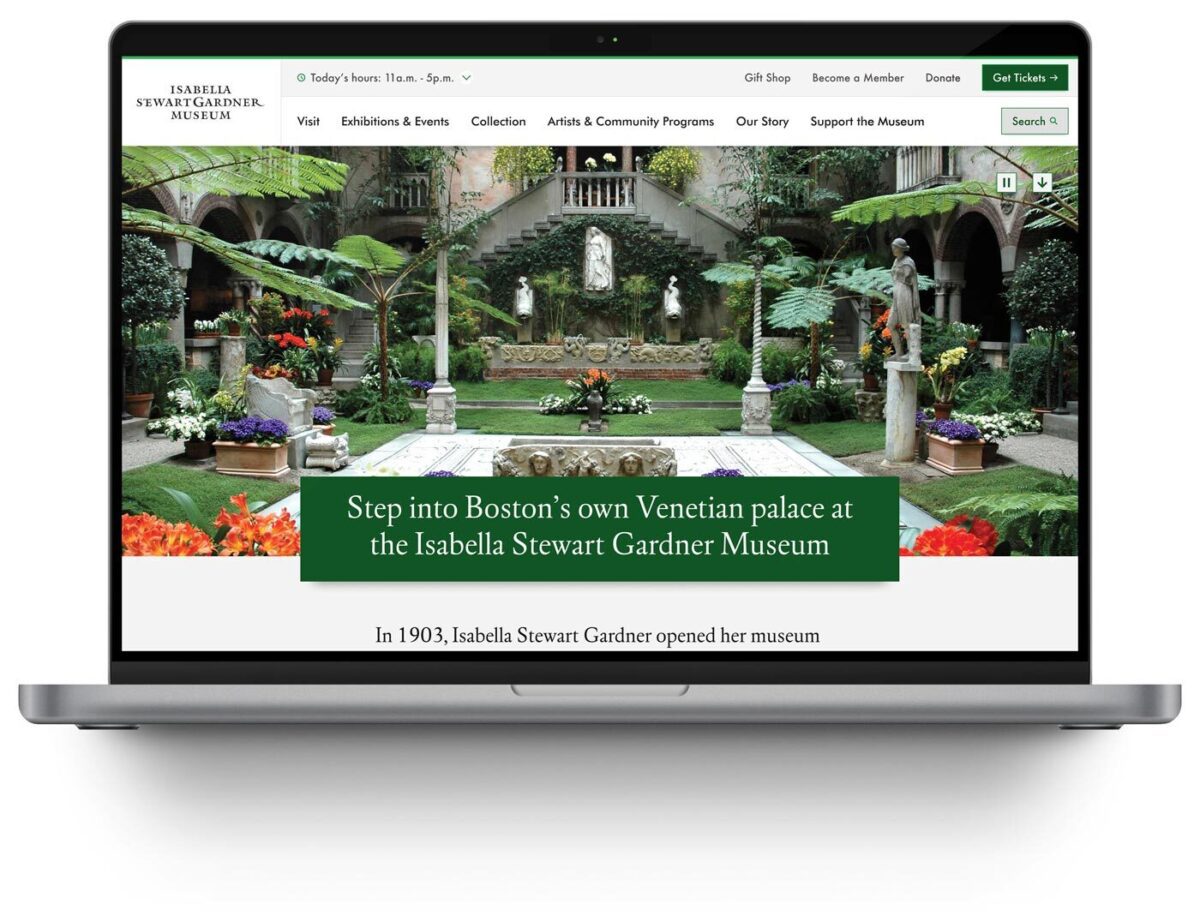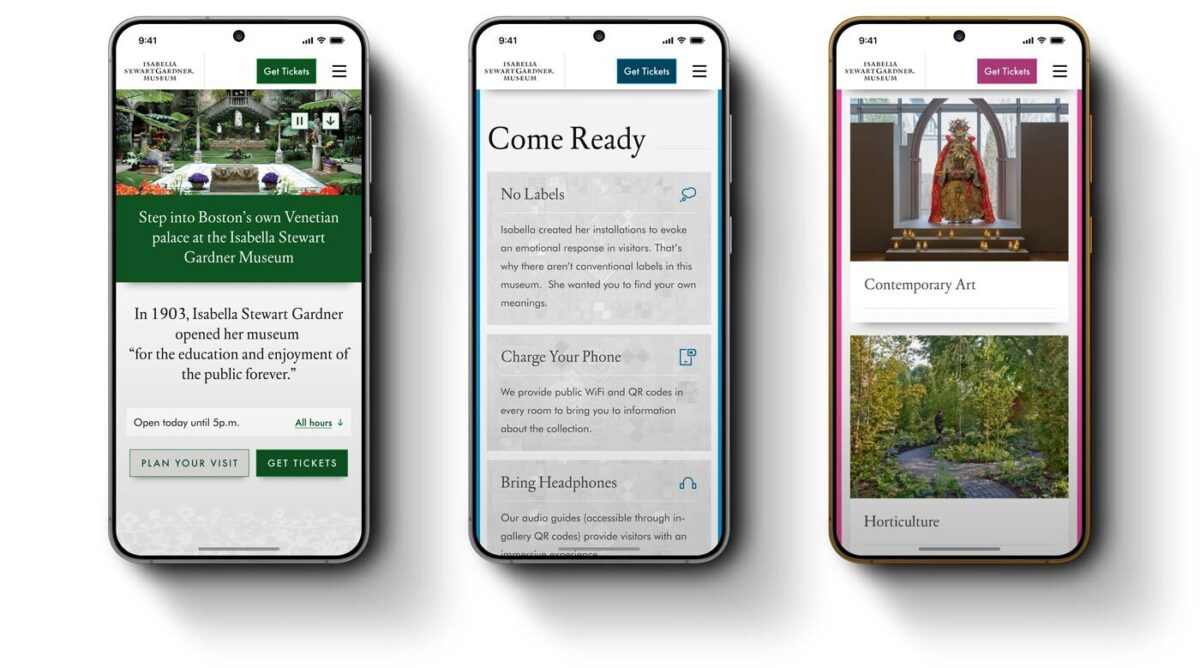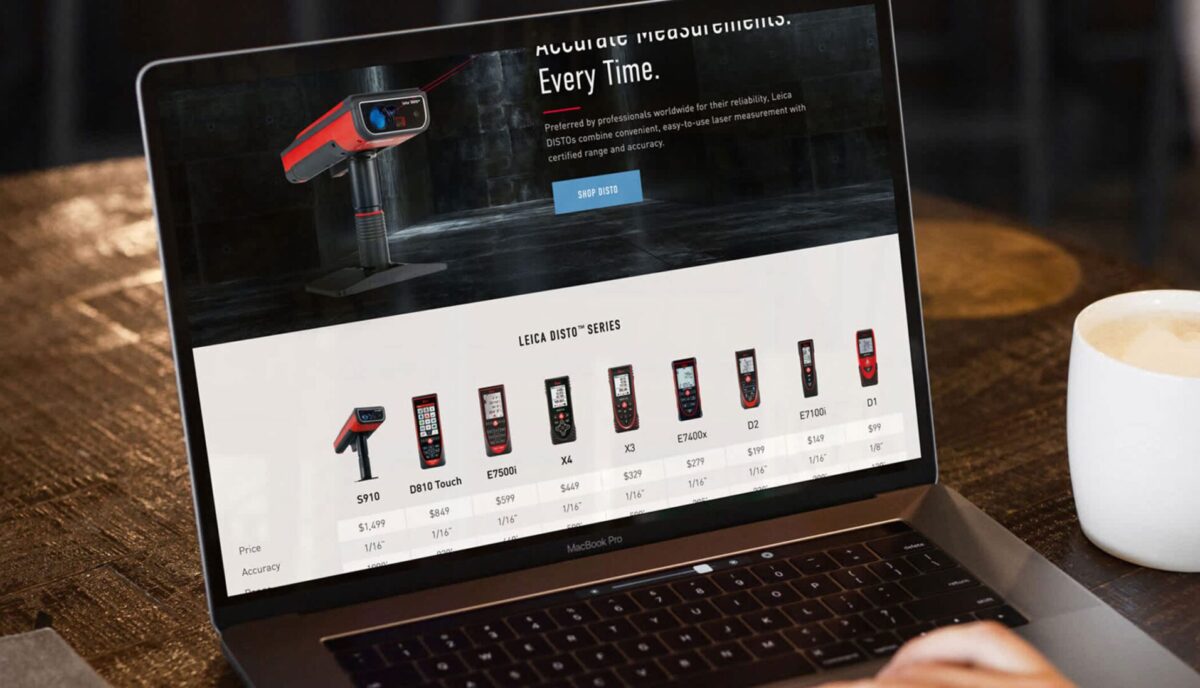Isabella Stewart Gardner Museum
Reimagining a Beloved Cultural Destination
Visit Site
category
Accessibility
Analytics & SEO
Content Strategy
Design & UI
Research & Strategy
User Experience
capability
Analytics & Measurement
Design Systems
Drupal
Flexible Page Building
Mobile & Responsive
User Research
industry
Cultural Institutions
When museum staff rely on Google to find content on their own website, meaningful visitor engagement becomes nearly impossible. The Isabella Stewart Gardner Museum — one of Boston's most distinctive cultural treasures — faced this exact challenge. Their website’s complex navigation and scattered content prevented visitors from planning trips or exploring the collection online. Rather than rebuilding from scratch, we proposed a strategic re-architecture that preserved the Museum’s unique visual identity while solving critical usability issues.
Homepage engagement time
Exhibition page views
“Inside the Collection” engagement time
Overview
The Isabella Stewart Gardner Museum stands as one of Boston’s most distinctive cultural treasures. Founded by the visionary Isabella Stewart Gardner herself, the Museum offers a transportative experience that defies conventional art museum expectations. Yet for all its in-person magic, the digital experience had room to better serve the institution’s mission.
The Museum needed a solution that would honor their unique brand identity while solving critical usability challenges that were hindering meaningful digital engagement.
Challenge
The Museum faced a variety of digital barriers that were undermining their core mission. Since launching a redesign effort in 2017, their website struggled with fundamental usability issues that created friction at several touchpoints:
The Findability Crisis: Staff members regularly used Google to locate content on their own website. The people most familiar with the site struggled to navigate it efficiently, highlighting how challenging the experience must be for visitors.
Accessibility Barriers: The website failed to meet current accessibility standards, with poor color contrast rendering content difficult to read for visitors with visual impairments. As an institution committed to welcoming all visitors, they have been spearheading important initiatives to review and remediate accessibility, including their digital platform.
Navigation Complexity: The previous design used internal logic that wasn’t intuitive to visitors, particularly those unfamiliar with the institution, treating many landing pages like a series of doors and frames. While visually striking, this approach created a maze-like experience that prioritized aesthetics over visitor needs.
Content Architecture Issues: Exhibition details, ticketing information, and visitor resources were scattered across the site without hierarchy or clear pathways between related content.
These challenges weren’t just inconveniences—they were preventing the Museum from achieving its core digital goals of inspiring visits, supporting trip planning, and fostering deeper engagement with their collection and history.
Our Approach
Rather than pursuing a complete rebuild that would disrupt operations and require extensive backend development, we opted for a strategic re-architecture. This approach allowed us to transform the user experience while preserving the visual identity and content management systems the Museum’s team relied on.
Our methodology centered on understanding both the institution’s unique character and their visitors’ diverse needs:
Discovery & Stakeholder Alignment
We began with comprehensive stakeholder workshops, bringing together team members from across the Museum to align on priorities and success metrics. By synthesizing member surveys, analytics data, and internal insights, we developed a clear picture of both current pain points and future opportunities.
User-Centered Design Strategy
We mapped core tasks to real visitor types by creating focused user journeys for Museum Members, purchasing a ticket, navigating the museum’s collection and information while visiting, and researching art online afterward. Our user journey mapping ensured every design decision served real visitor needs.
Information Architecture Transformation
We rebuilt the site’s navigation and menu system, creating intuitive pathways that support natural user behavior. TreeJack testing validated our approach, ensuring the new architecture would actually improve task completion rates.
Accessibility-First Enhancement
Newly designed components aligned with WCAG 2.2 AA standards, proving that accessibility and aesthetic excellence aren’t mutually exclusive. We demonstrated how inclusive design could enhance the Museum’s distinctive visual character.
“Gentle Elegance” Design Philosophy
Working closely with the Museum team, we developed a design approach that captured the institution’s intimate, sophisticated character through subtle details—lace patterns and mosaic elements that reference the collection and architecture without overwhelming the interface. This strategy allowed us to inject personality into the digital experience while maintaining focus on usability.

Strategic Solutions Delivered
Enhanced Navigation Architecture: We introduced drop down menus and logical content groupings that transformed how visitors move through the site. Museum websites often avoid complex navigation, but we proved that thoughtful hierarchy actually improves rather than complicates the user experience.
Reimagined Visit Page: This became the crown jewel of our transformation—a comprehensive resource that balances practical planning information with pathways to deeper content exploration. The page now prepares visitors for the Museum’s unique characteristics (awareness of the lack of labels, availability of audio guides and mobile device charging stations, etc.) while building excitement for the experience ahead.
Component System Redesign: Our new component library enables the Museum’s team to create engaging content layouts without sacrificing accessibility or performance standards.
Performance Optimization: Behind-the-scenes improvements ensure the site loads quickly and functions smoothly across all devices and connection speeds.

Measurable Impact
The transformed digital experience delivered immediate, measurable improvements across every key area of visitor engagement. Three weeks after launch, the data tells a compelling story of enhanced user behavior and meaningful interaction with the Museum’s digital presence.
Enhanced Homepage Engagement: The redesigned homepage achieved a 9.7% increase in views alongside a significant 15.6% increase in average engagement time, demonstrating that visitors are not only discovering the site more frequently but spending meaningful time exploring what it offers.
Dramatic Exhibition Discovery: The Exhibitions section experienced remarkable growth with a 179.7% increase in views and 22.9% higher engagement time. This transformation demonstrates how improved information architecture and content discoverability can dramatically expand visitor interest in the Museum’s programming.
Deeper Content Engagement: The Inside the Collection blog saw an 18.4% increase in views coupled with an impressive 61.7% increase in average engagement time. Visitors are not only finding this content more easily but engaging with it far more meaningfully, suggesting successful pathways between practical planning content and deeper cultural exploration.
Strengthened Community Connection: The Membership section achieved a 15.7% increase in views with steady engagement time growth of 2.5%, indicating improved pathways for visitors interested in developing ongoing relationships with the Museum.
These metrics validate our strategic approach of balancing usability improvements with content discoverability. The data shows visitors are finding information more efficiently while also discovering opportunities for deeper engagement with the Museum’s mission and offerings.
Why This Project Matters
Isabella Stewart Gardner created something unprecedented: an intimate, personal art experience that defies conventional museum expectations. Every element was chosen and placed with intention, creating an environment where visitors don’t simply observe art—they step into a carefully curated world.
This uniqueness creates both opportunity and responsibility in the digital realm. The website serves as many visitors’ first encounter with the Museum’s distinctive character. When that initial experience is confusing or inaccessible, it undermines so much of what makes the Gardner special.
Our strategic approach recognized that preserving the Museum’s essence required more than maintaining visual elements — it demanded understanding what makes the institution extraordinary and translating those qualities into digital interactions. By balancing usability, accessibility, and aesthetic sophistication, we enhanced an online experience that genuinely reflects the Gardner’s spirit.
The transformation supports the Museum’s broader mission in measurable ways:
Visitor Empowerment: Clear, accessible information helps visitors plan with confidence and arrive prepared for the Gardner’s unique approach to art presentation.
Deeper Engagement: Improved content discoverability means the relationship with the Museum can extend beyond the physical visit through blog content and collection exploration.
Inclusive Access: Meeting accessibility standards ensures the Gardner’s digital presence welcomes all visitors, reflecting the institution’s commitment to openness and equity.
Operational Excellence: Streamlined content management empowers staff to focus on mission-critical work rather than wrestling with technical barriers.
Ultimately, this project demonstrates how thoughtful digital transformation can honor an institution’s distinctive character while removing barriers to meaningful engagement. We didn’t just improve a website, we helped the Gardner Museum extend its intimate, intentional spirit into the digital realm, ensuring that more people can connect with what makes this cultural treasure truly extraordinary.
AWARDS & RECOGNITION


